143 Days of a Migrant Justice Morcha in Canada
"I already became pakka in the moment, when I left my crying parents and sisters [in Punjab], and boarded the plane to come here."
Amardeep Kaur | @AmardeepKaurPhD
On 22nd June 2024, a group of protesters with Naujawan Support Network (NSN) marched by Brampton Gateway Terminal, distributing flyers to passers-by, holding protest signs by the roadside, and speaking out about Canadian immigration barriers. They were organized under the banner “Good Enough to Work, Good Enough to Stay.” As the rain intensified, protesters came on to the busy intersection and chanted “No More Komagata Maru”, before being halted by the police.
We might see the visibility of certain social issues when moments like these erupt. But this protest and its respective migrant justice movement has been brewing for awhile. After their studies, many graduating international students work on post-graduate work permits (PGWP) in Canada and fulfil requirements to qualify for a particular class of permanent residency. During the COVID-pandemic, Canada hailed them as frontline heroes. These were workers delivering take-out food orders on bicycles and Amazon packages. Despite fulfilling requirements, these immigrant workers have been left to wait in a bureaucratic red tape of draws and now told that they are no longer desired.
At the beginning of 2024, international students and immigrant workers began to organize on this front. The less visible backline organizing consisted of reaching out to political representatives, holding community townhalls, networking with fellow workers, and engaging stakeholders to find solutions to their migrant plight. In the summer, rallies and marches took place in parks and public squares. Finally, a pakka morcha (permanent protest) went up in Brampton at the end of August, organized by the PGWP Committee. The 24/7 encampment ran for 143 days into the new year.
The Morcha from Summer to Winter
The morcha was initiated with Ardas on a hot afternoon of June 2nd at Chinguacousy Park. Local sevadars carried out chabeel seva and distributed it to the ralliers. The rose syrup cooling drink (chabeel) is made to commemorate Guru Arjan Sahib’s martyrdom.
At the next rally, despite the taunting of a far-right media outlet, protesters took to a busy intersection to make their voices heard on their terms. The chant “No More Komagata Maru” erupted in the downpour.
The phrase references a Japanese ship, known in Canada as the SS Komagata Maru, that journeyed from Hong Kong to Vancouver in 1914 carrying Punjabi passengers from Sikh, Muslim, and Hindu backgrounds. The ship was bestowed the name Guru Nanak Jahaz in Hong Kong when Guru Granth Sahib’s saroop was brought onboard. In Vancouver, the bulk of the passengers were refused entry because they had not made a direct journey from their country of origin. During this time, Canada had erected a racist law called Continuous Journey as a cover to bar people of colour.
The ship was forced into a transPacific journey in reverse and then refused back to Hong Kong, as the British feared that Ghadar revolutionaries onboard would provoke a mutiny among Hong Kong Sikhs, who were serving the British colony in the ranks of policemen and prison guards. Consequently, the ship was directed to India and docked at Budge Budge. Some tried to align a nagar kirtan to bring Guru Granth Sahib to a gurdwara in Calcutta. A massacre followed that led to the lost of some passenger lives.
In recent years, Canadian politicians have co-opted the ship’s racial, religious, and migrant struggles by placing the ship as an ‘incident’ of the past and to sell a redemption lie. Yet, in expressing “No More Komagata Maru”, the protesters remind us that Canada continues to commit atrocities against Punjabi immigrants.
On a rainy Friday night, 30th August 2024, the encampment was laid down by the PGWP Committee as a site of a 24/7 protest. In taking on this decision, it felt it had exhausted the previous means of organizing that encompassed meetings, petitions to representatives, community townhalls, and weekend rallies. The encampment was located on public grounds in the vicinity of a strip mall–Bramrose Square Plaza–by a busy highway in Brampton, an outer suburb of Toronto.
The early days of the encampment consisted of an open communal tarp on the lawn, with two sleeping tents. Signs facing the sidewalk read: “Stop Hate and Racism”; “Stop Scapegoating Immigrants”; “No One is Illegal on Stolen Land”; “We Reject Your ‘Use and Throw’ Policy”.
Police regularly cruised the site with intimidation and harassment tactics. The police ordered that anybody affiliated with the encampment had to be north of the trees and could not use the mall parking lot. Since then, a private fence was contracted and erected by the strip mall.
On the blue tarp, people came together for rallies, speeches, seminars, langar and Sikh sacred poetry. In the evening, Rehras Sahib was recited from the Sikh faith. In the days ahead, Hanuman Path from the Hindu faith became a regular recitation as well.
As the season progressed into the winter, the morcha set up a covered communal canopy to shield against the wind and rain. At the top of the canopy sat a sign: “No More Komagata Maru”. Inside, a make-shift divan was assembled. Protesters sat on mattresses and blankets on top of a raised wooden platform made to insulate from the coldness of the ground. Multiple tarps reinforced the sides for an added insulation layer against wind gusts. Even with electric blankets and portable heaters, I felt a chill inside. Shawls and phoolan wala kambal (flower blankets) were the go-to norm. Outside, a barrel of fire brought together a circle of young and old warming their hands. Shared body heat, and cups of cha with pinnia kept folks nourished and cared for. A plastic water bottle was warmed up in the microwave for drinking. A power generator ran the site. A can of kerosene used daily. The encampment was equipped to hold film screenings, langar, plays, rallies, teach-ins, and press conferences.
In one teach-in, Nick Estes, with Lower Brule Sioux Tribe, spoke about the Standing Rock encampment against oil pipelines. Estes called for grassroots solidarity across marginalized groups and to stand together against the exploitation of Indigenous lands and the dehumanization of international students and immigrant workers in Brampton.
“That this economy is in a permanent state of need for so-called migrant temporary laborers. But they’re not allowed to be permanent. Why? To cheapen their lives. To make them expendable. Just like they make Indigenous people’s lives and lands expendable.”
Following radical practices of langar in the Sikh ethos, the encampment ran a food for all policy. Snacks and cha are served to all guests at the beginning of a rally. A full meal langar is distributed at its conclusion. Langar usually comes from a gurdwara in Malton. Families and small businesses helped too. Following Day 100 rally, an elder wishes chardi kala to the youth, alongside a commitment of more seva: “I will return with sarson da saag and makki di roti for you sometime.”
Ghadar, Poetry, and Jakaras
There are days of tears and glimpses of hope. A Punjabi poem spoken goes viral. A song contemplates the sorrow of suicide that surrounds migrant journeys. An Ardas is held for Gursimran Kaur–a worker who lost her life inside a Walmart oven in Halifax. A silent candle march is undertaken to mark Black Diwali. Some hold the LEDs with their fingers. Others lay it on their palms. Weeks become months. An ode to Guru Nanak is made. A Ghadari is remembered.
On Day 30, there were tears in my eyes, just as cries filled the row of lined protesters in front of me wearing the movement’s black t-shirts. Mehakdeep Singh was reading a poem.
I already became pakka in the moment, when I left my crying parents and sisters [in Punjab], and boarded the plane to come here.
Pakka in Punjabi has multiple meanings. Permanent. Certain. Hard. Ripe. There’s no easy English translation here, because Mehakdeep Singh’s point is inherently one of multiple contradictory usages. It expresses grief and hardship, while still presenting the resiliency. It characterizes chardi kala, not as the celebratory optimism, but rather as one of struggle and resilience in the face of adversity. It questions what status as a permanent residency card on paper even means, when his body hardened as a migrant student from his early days. The ground from underneath his feet slipped. Uprooted a long time ago from Punjab. He lost his youth and was forced into the harsh environment of an international student and immigrant worker. He’d miss stops, fallen asleep on the bus after a long shift.
Mehakdeep Singh expresses his words with rawness and anguish in voice, unfiltered, while being held and comforted by a comrade standing next to him, rubbing his torso. The folks around are weeping.
We became pakke (ripe/hardened/permanent) a long time ago. PR is such an unripe thing.
On Guru Nanak’s gurpurab, Sikhi’s founder was honoured through a reading of the poem “Nanak”, penned by Jaswant Zafar.
Day 79 brings a commemoration to a Ghadar revolutionary who was executed. Kartar Singh Sarabha was a revolutionary who joined the Ghadar Party in 1912. He went back to India to fight the British. He was arrested and executed. He inspired other Ghadaris and the freedom-fighter Bhagat Singh, who carried Sarabha’s photo everywhere in his pocket.
The evening was filled of poetic exchanges. Novjot Salaria is at the forefront of the PGWP committee. Since this movement, she has been working both at her job and organizing at the morcha. She tells me she learnt some Ghadar poetry learnt from her dad during her childhood in Punjab. She revisited this poem from Kartar Singh Sarabha:
jo koi pooche ke kaun ho tum
to kah do baaghi hai naam apna
zulm mitaana hamaara pesha
ghadar ka karna hai kaam apna
namaaz-sandhya yahi hamaari
paath pooja bhi sach yahi hai
dharam karam sach yahi hai yaaro
vahi khuda bhi o ram apnaif they ask you who you are:
say your name is Rebel
eradicating tyranny is our occupation
revolting is our work
this is our namaaz, our sandhya
this is our way and worship
this is our faith and grace, O friends
and this is our Khuda, our Ram
(Kartar Singh Sarabha, translation mine)
When marches and rallies conclude, jakaras are raised. The rallying cries to Waheguru are a reminder of the intertwine of anti-oppression politics and the Spirit. One international student came to the morcha to offer her solidarity. She incites that struggles for justice belong to those whose conscience is awake:
When we hand the strings of our kites to Akal Purakh, then Akal Purakh Waheguru steers it. May Guru Patshah bestow kirpa (grace). We shall win the battle, because the struggle is the sign of those whose conscience is lit.
Good Enough to Work, Good Enough to Stay
The present movement clustered in Brampton has drawn inspiration from the anti-racist and migrant organizing of Caribbean domestic workers in the 1970s and early 1980s. In the 1970s, when the points-based system of immigration was first introduced, sectors such as domestic work were excluded from permanent residency.
During that time, Canda had deported seven Jamaican mothers and workers for not declaring their dependent children back home. In turn, they organized and made the proclamation, “Good Enough to Work, Good Enough to Stay.” Elaine Peart, one of the Seven Jamaican Mothers, addressed the state’s exploitation of Black women’s labour: “We were brought here to clean rich folks’ home and now we’re not cleaning rich folks’ homes, so you want to throw us out.” The organizing of the Black Caribbean women galvanized a larger migrant justice movement which made gains for eventual permanent residency among foreign domestic workers.
The 2024 Good Enough to Work, Good Enough to Stay movement emerges from the state’s exploitation of international students for cheap labour and international tuition fees. Having used international students as cash cows to prop up an underfunded post-secondary education system and Canadian economy in the pandemic, they are being scapegoated by Canada.
Throughout 2024, international students were impacted with sweeping migrant rights rollback across Canada. For prospective, study permits have been capped. For PGWP holders, permits have been left to expire, and any path to PR placed behind bureaucratic red tape. Federal targets on permanent residency have been slashed while provincial programs were closed abruptly or drastically undercut. Protests broke out in various provinces, namely, British Columbia, Prince Edward Island (PEI), Manitoba, Ontario, and Quebec. In PEI, workers in service sectors were left hanging as the program favoured healthcare and construction sectors. This stranded many graduated international students who initially moved to the province to take on retail jobs. Rules were changed overnight without grandfathering those on the path of residency via post-graduate work qualifications in service work.
“Study, Explore, Work, Stay” was Canadian government’s motto to attract international students to immigrate to Canada. The chronic underfunding of post-secondary education, alongside globalization of universities and colleges, has meant that Canada could prop up education as a capitalist industry while doubling down on their cheap labour. Attracting young people to Canada through this motto was simultaneously accompanied by de-favouring family sponsorships in the parents and grandparents category.
During the pandemic, the Canadian government flexed rules–for example, lifting restrictions on hours–in order to boost international students to work the unsafe essential jobs that Canadians did not want to do. In 2021, at the height of the pandemic, the Immigration Minister, Marco Mendicino, tweeted: “We don’t just want you to study here, we want you to stay here.”
Back at the morcha, memes on Marc Miller highlight the Canadian flipflop in the interest of election polls. Protesters denounced such ‘use and throw’ policy.
Collectively, 2.3 million permits are expiring in 2025 and 2026. This will leave many migrant workers stranded and pushed into undocumented and exploitative conditions. Migrant Rights Network have called this “an unacceptable betrayal of Liberal promises by way of Conservative-style immigration policy.”
Echoing the work of migrant justice advocates and organizers, a United Nations report found that the Canadian immigration regime is “breeding ground for contemporary forms of slavery.”
There are four demands of the present protest in Brampton: 1.) Extensions on post-graduate work permits that are expiring in 2024 and 2025; 2.) a five-year post-graduate work permit for all international students; 3.) ending exploitation that results from the system of Labour Market Impact Assessment (LMIA); and 4.) establishing a fair pathway to permanent residency.
These demands were formulated in May 2024 following extensive community consultations and townhalls with work permit holders and international students.
In December, on Day 110 of the encampment, a partial victory was announced with changes to the role of LMIA, that has some potential of reducing LMIA-based exploitation. Headed into the Gregorian new year and Canadian winter, and remembering the shaheedi days of Char Sahibzade, the protest remained steadfast in their unwavering pursuit.
Building a Movement of Solidarities amidst Deaths
Throughout 2024, much anti-Sikh racism and hate spread online, giving rise to the current xenophobic wave in Canada (PressProgress, 2024). On X, I came across countless viral, AI-generated imagery of Sikhs having overtaken Tim Hortons. Right-wing groups, such as Rebel News, made it their mission to intentionally target international students – given their vulnerability and marginalized status. On social media, there are hate-fueled comments berating Sikh or Punjabi international students with racial remarks over body, hair, turban, language, accents, smells, and rural manners.
Solidarity for the morcha has come from labour unions, anti-racist groups, and migrant justice organizations.
A major player at the morcha organized by the PGWP Committee is the Naujawan Support Network (NSN). NSN was founded in 2021 amidst a crisis of losing young lives–mostly from the Sikh or Punjabi community–to suicide. These were international students who were dealing with wage theft, unsafe work conditions, sexual harassment, and deportation threats. Employing direct action tactics, NSN’s movement has recovered $850,000 of stolen wages since then.
At a downtown Toronto action led by the Migrant Rights Network, NSN member Bikram Kullewal addresses the rally:
I’ve never seen as much racism online, and on the streets of Canada, as I do now. Our coworkers are being attacked, even killed. One of our brothers–he was working at Tim Hortons in Edmonton. Somebody killed him with a knife. Many are still dying while doing dangerous jobs. Some have died by suicide.
Kullewal is referring to the stabbing of Jashandeep Singh, an international student who was attacked and killed while working a shift at Tim Hortons. The death of a recent immigrant Gursimran Kaur created another sombre ripple across Canada and at the Brampton encampment just before Bandi Chor Diwas. She was working at Walmart when she died in the store’s industrial oven.
Jashandeep Singh, 22, Edmonton
Gursimran Kaur, 19, Halifax
Gurasis Singh, 22, Sarnia
Harshandeep Singh, 20, Edmonton
By the time of the next rally, more deaths have accumulated. These are lives taken prematurely, from workplace death to racist or xenophobic violence to suicides. Names are read out as they are remembered, in this account, by Elisha Lim, a York University professor offering solidarity:
Charandeep Singh, a 22-year-old from Brampton who commits suicide earlier this year by jumping off Niagara Falls because he could see no way to repay the debt that his family had gone into to send him to be an international student in Canada.
Data on suicides by international students is not kept by Canadian records, making intervention difficult. Alarms on this crisis have been sounded by funeral homes, gurdwaras, and support organizations. Many times, communities get together to raise funds to repatriate the young departed bodies to Punjab.
On International Migrants Day, a gathering is held in Toronto at the Chinese Railway Workers Memorial, led by the International Migrant Alliance. The rally connects past struggles with present movements. The Filipinx organizers read out the lives lost in different migrant communities–from Mexican farmworkers to Punjabi international students:
Charandeep Singh, 22, Brampton
Bhavjeet Singh, 21, Mississauga
Sukhpreet Singh, 21, Mississauga
At the heart of this issue is the politics of disposability inherent in Canada’s white nation-building project. Racialized and working-class immigrant workers are first recruited for work Canadians do not want to do. Subsequently, racialized immigrants are blamed by the state as various levels of governments divert attention away from the governments’ own lack of social provision to the marginalized classes of Canada.
A solidarity statement signed on by labour unions and community groups calls out this racist treatment in the hands of Canadian governments:
Lauded as “heroes” and exploited as cheap labour, they are now being told they are disposable and unwanted. This treatment on the part of our governments is racist, irresponsible, unacceptable, and unjust.
The joint groups hold a press conference at the encampment in November with their statements. Meanwhile, Novjot Salaria traveled to Ottawa to deliver an address on behalf of the PGWP Committee.
The 2024 migrant rights rollback by the Canada government is just the latest example in a history of a white settler project. The Chinese railroad workers were paid less than their white counterparts and who worked the dangerous segment of the cross-Canadian railway. Following its completion, Canada centered the yellow peril discourse leading to the Chinese head tax and the Chinese Exclusion Act. Black Caribbean women recruited into domestic work in Canada were blamed for employment crises in the 1970s.
The current movement continues to build inter-racial, inter-faith and cross-ethnic immigrant workers solidarity. The evening on International Migrants Day ended by exchanges of chants between the Punjabi and the Filipinx migrant communities.
Long Live International Solidarity.
The People United Will Never Be Defeated.
Worker’s Unity, Zindabad. Zindabad, zindabad.
With Trudeau’s fall, and Parliament on hold, the PGWP Committee disbanded the encampment on Day 143 (19 January 2025), to switch tactics and explore more methods in the next phase of the movement.
Dr. Amardeep Kaur (X: @amardeepkaurPhD) is a lecturer at University of Toronto where she teaches Sikhism and Canada-Hong Kong Migration. Kaur’s doctoral research reclaimed Guru Nanak Jahaz from the counterpart SS Komagata Maru. When not teaching or writing, she likes walking and drinking endless cups of cha. You can follow the Guru Nanak Jahaz movement-building initiative on IG and X: @GuruNanakJahaz


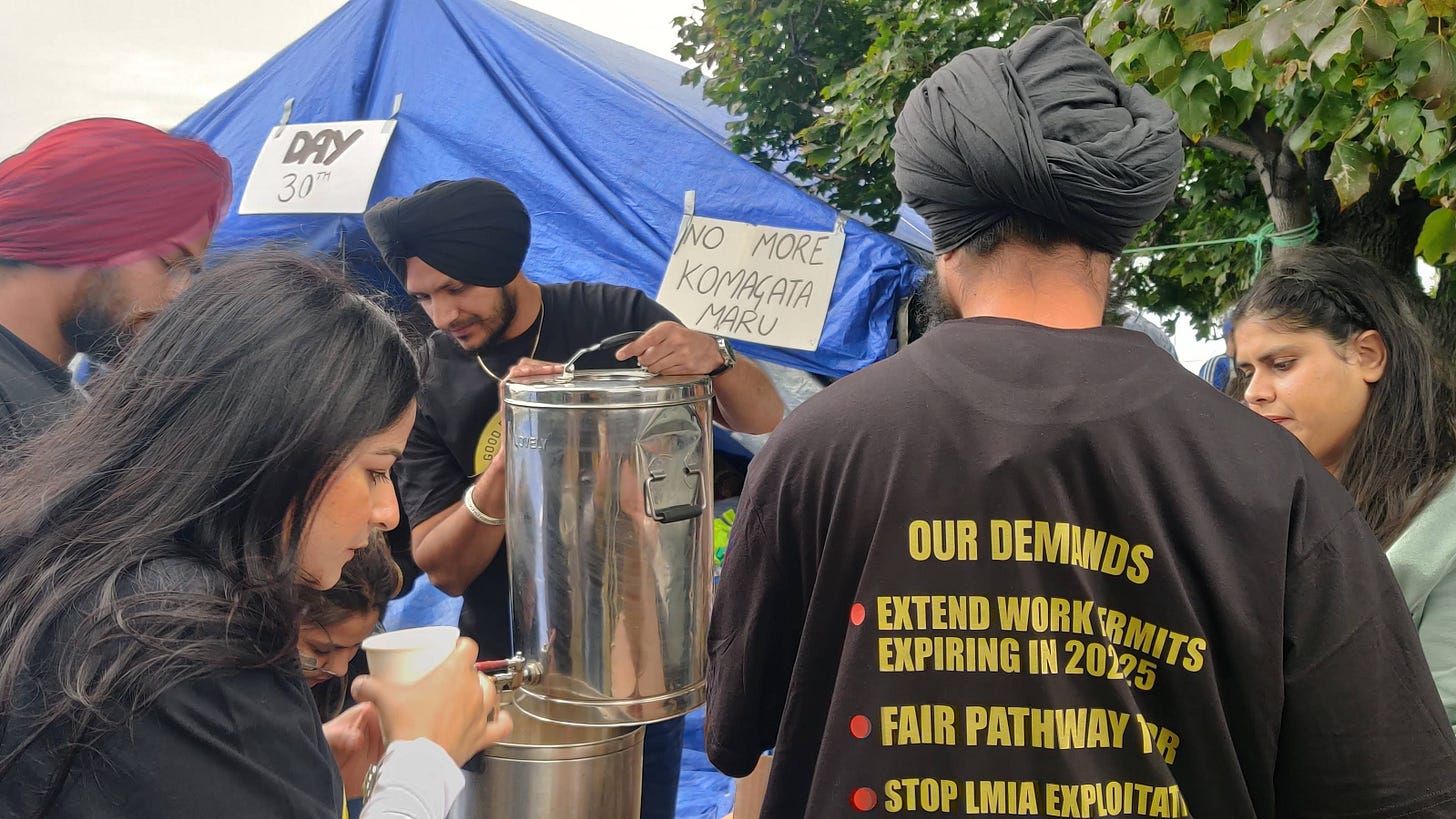
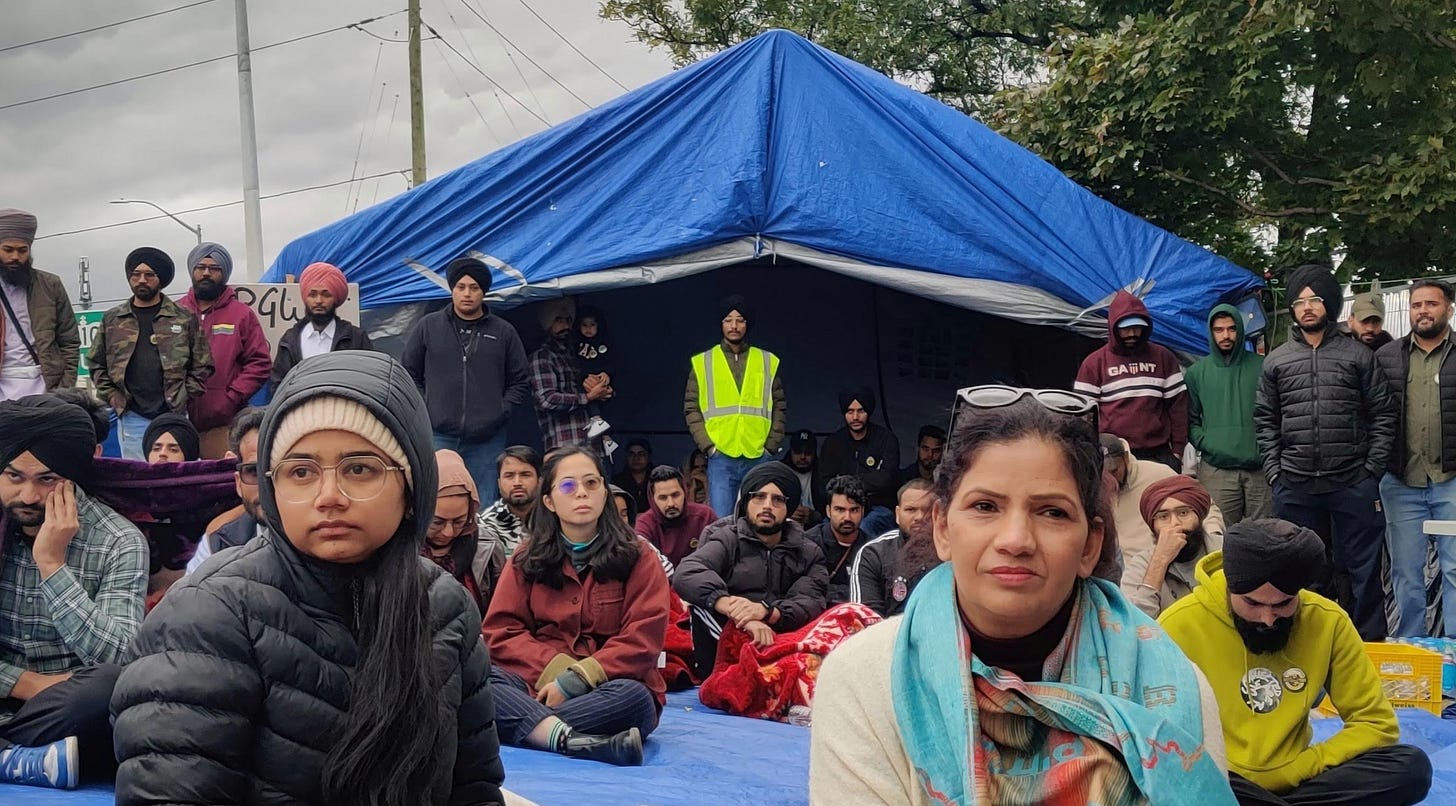
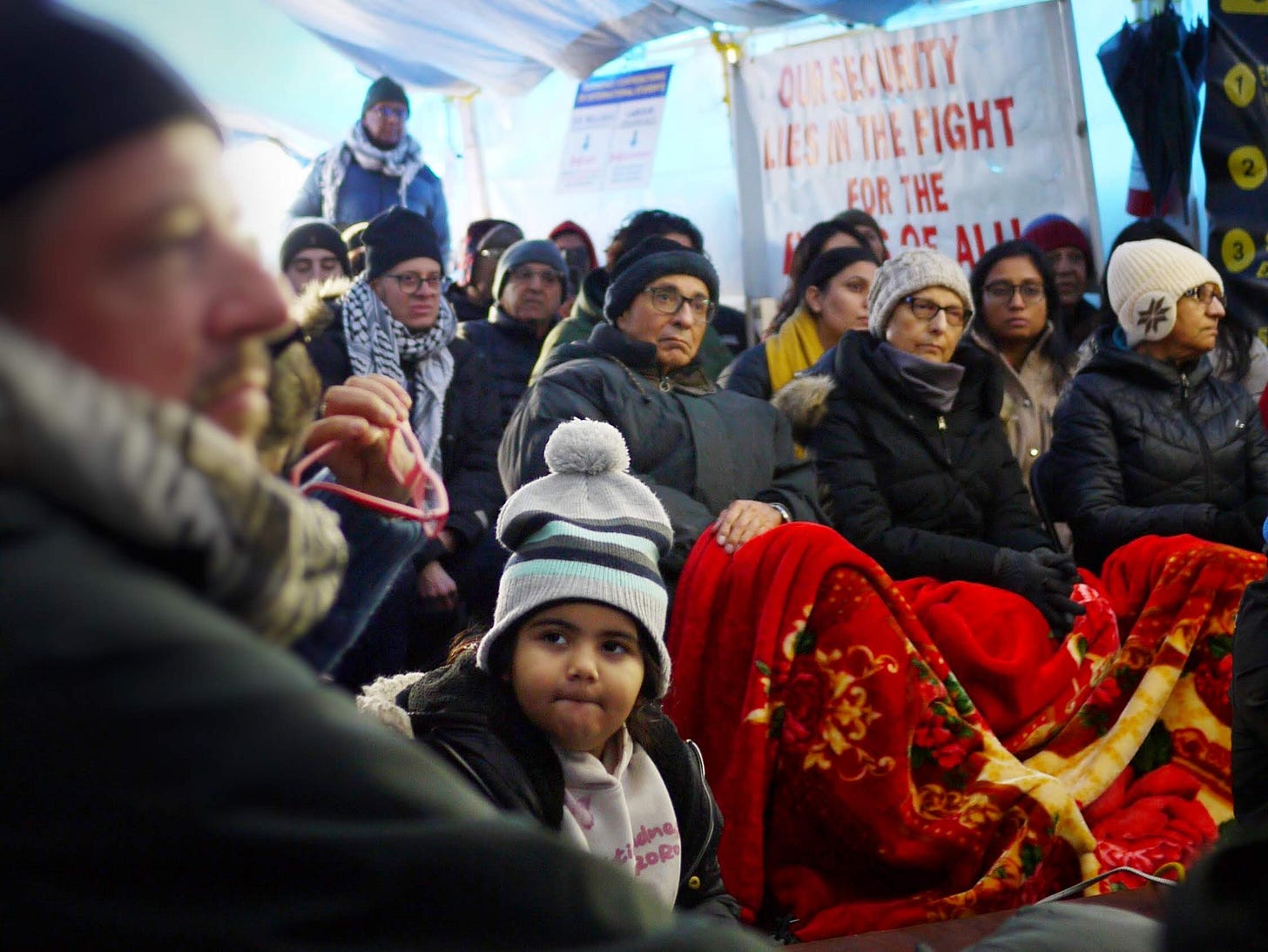
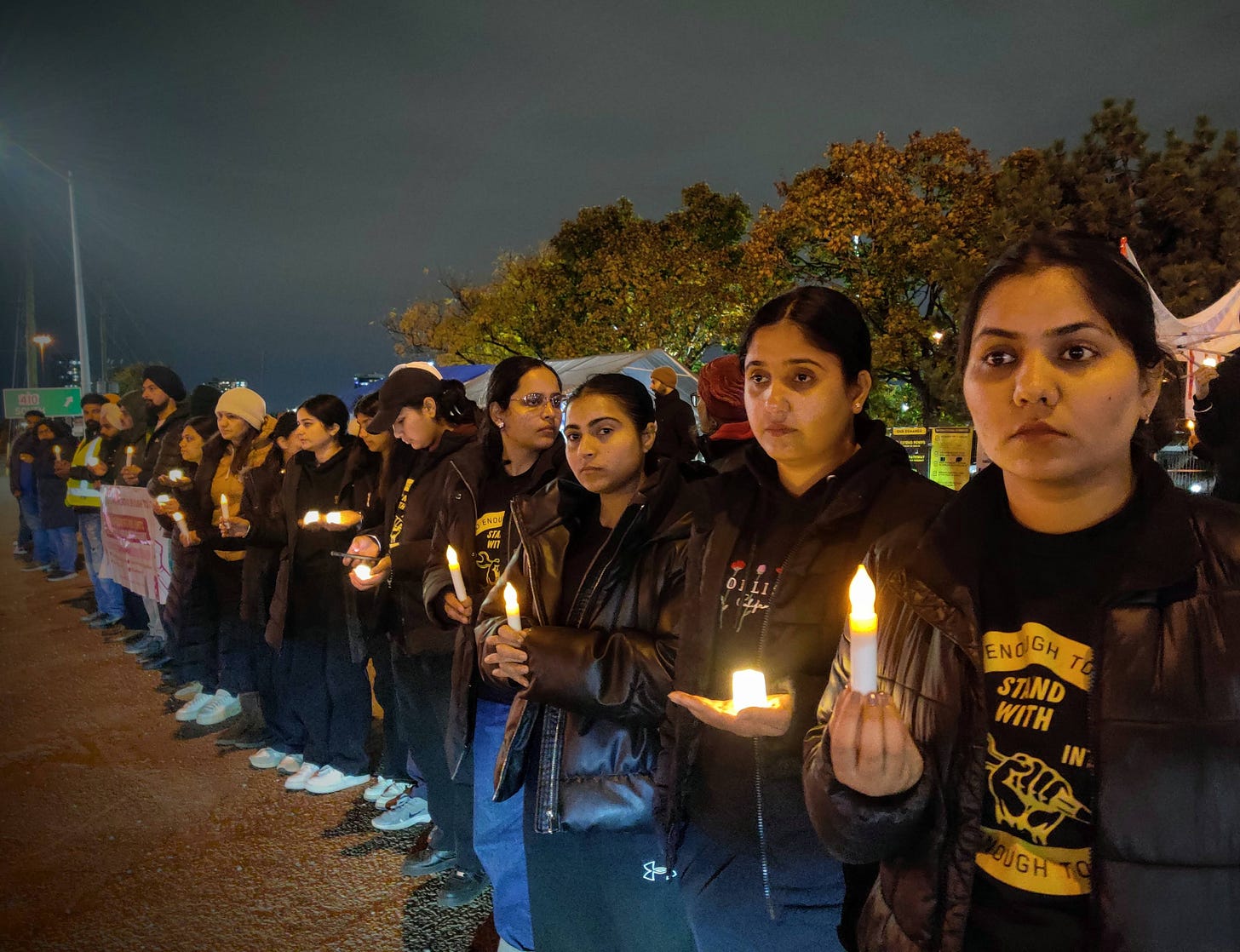
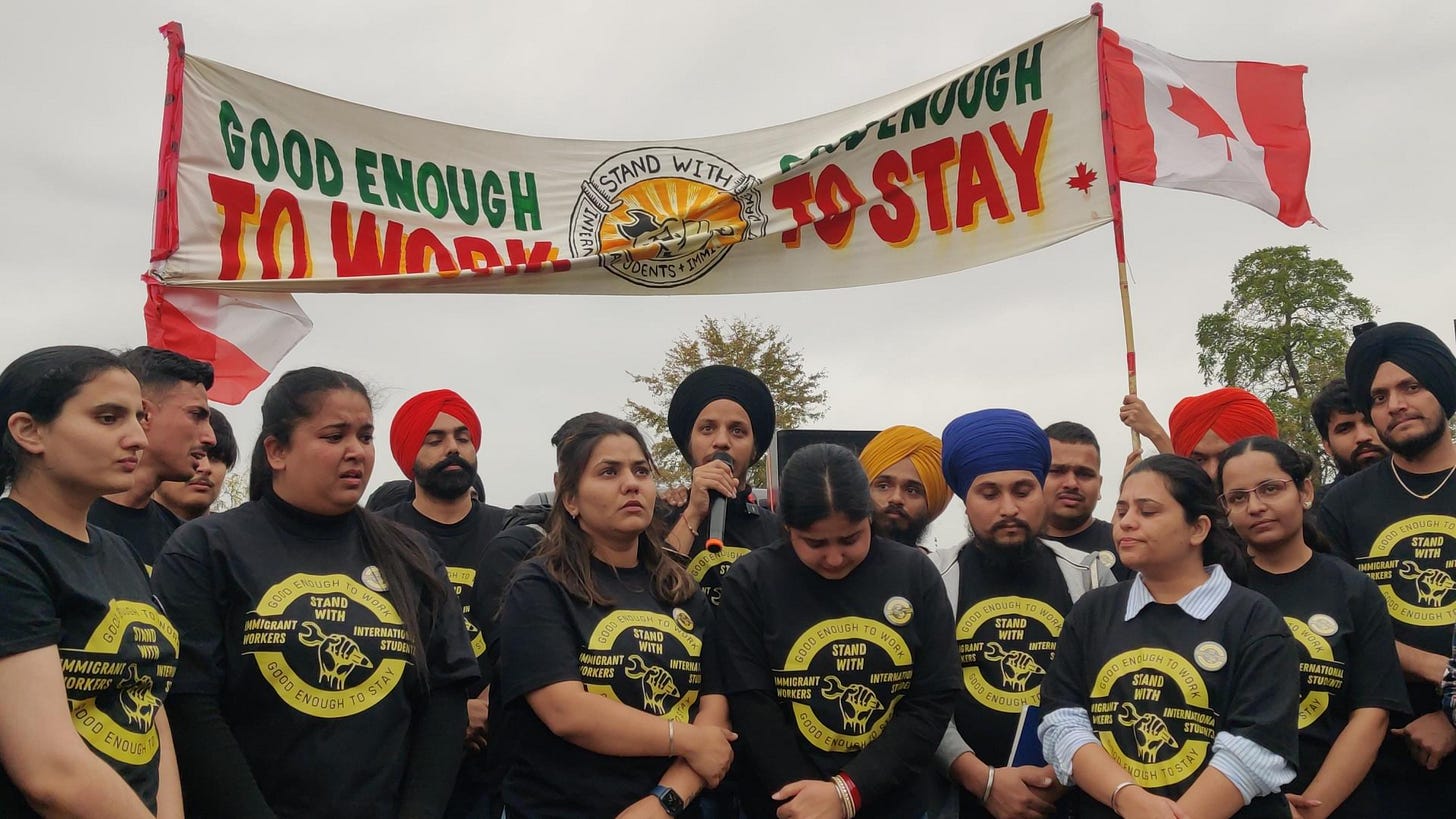
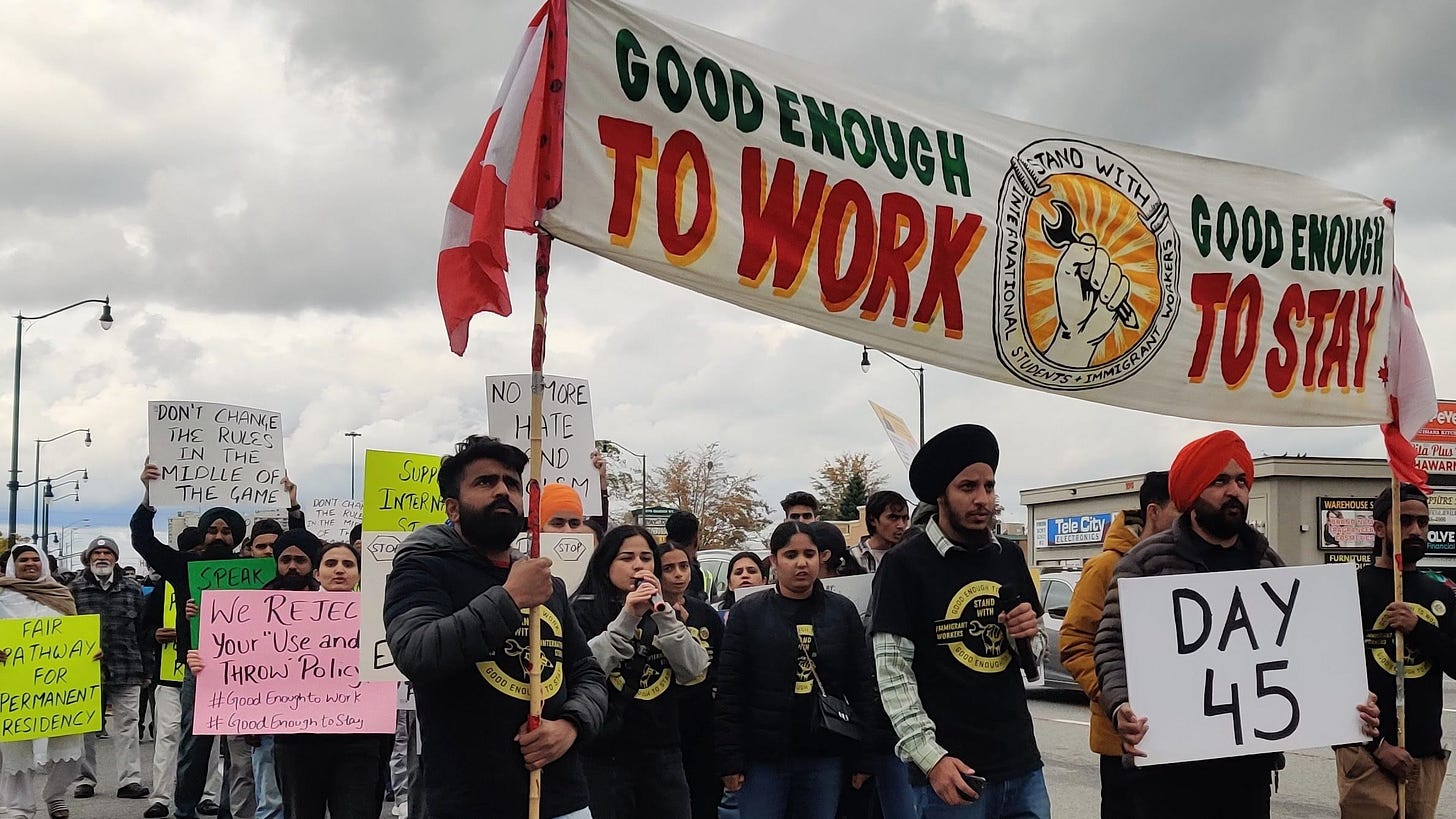
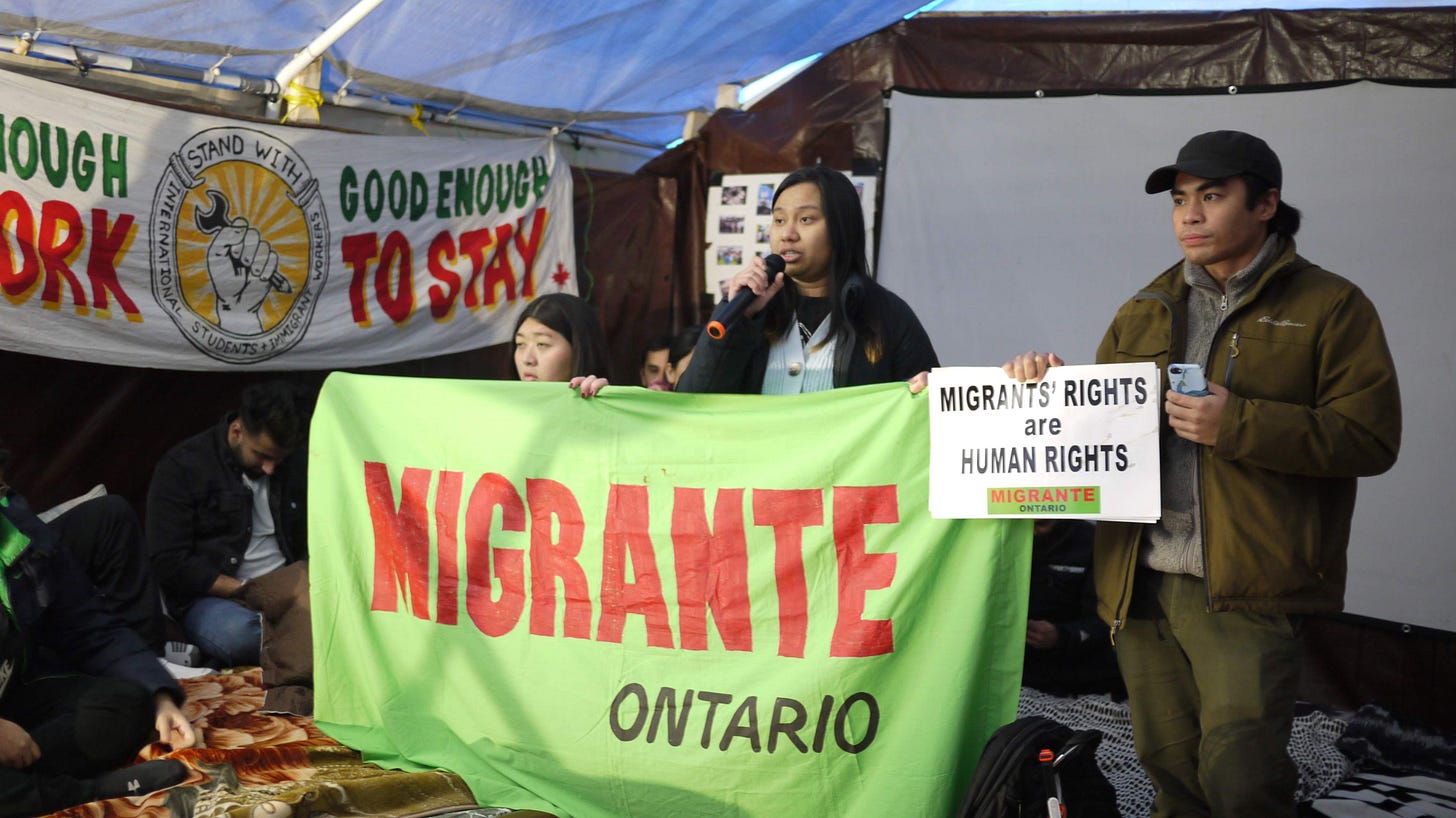
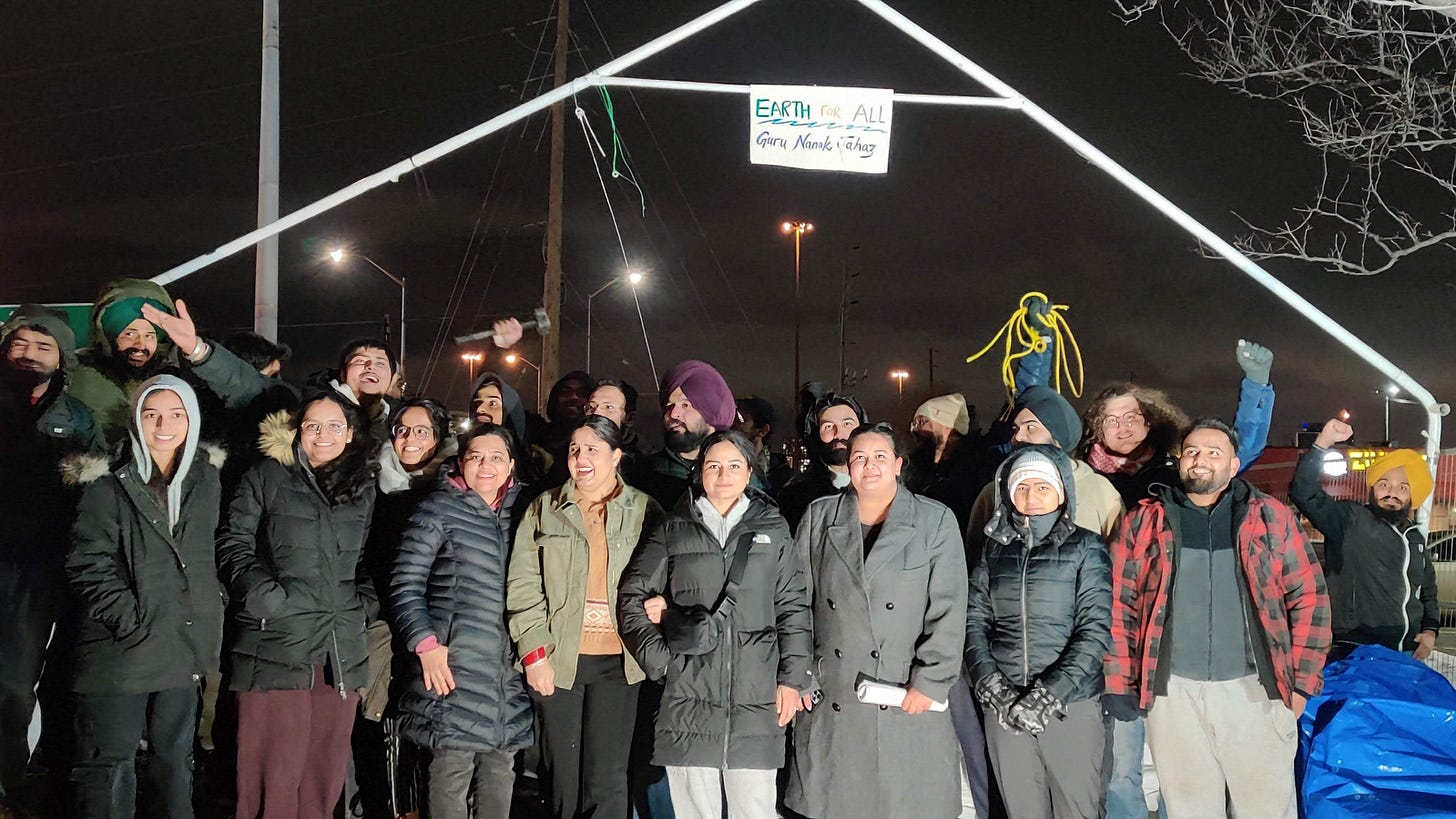
If the government is so xenophobic and racist in addition to the white settler project as you mentioned. Then why are people so desperate to stay in the country? Help me explain this logic. If you think a country is merely a 'stolen land', wouldn't an intelligent person stay away from the land which is forcefully occupied?
This is what you wrote:
"Collectively, 2.3 million permits are expiring in 2025 and 2026. This will leave many migrant workers stranded and pushed into undocumented and exploitative conditions. Migrant Rights Network have called this “an unacceptable betrayal of Liberal promises by way of Conservative-style immigration policy.” "
If someone's stay in a country is coming to an end, how does that equate to that person going all the way to commiting fraud and going into an underground economy? You're implying that these people have no agency or no rational thought behind their actions.
When you come to Canada you have to provide a proof of funds which ensures that you are capable of supporting yourself during your study. Then why do people play russian roullete with their lives such as acquiring high interest loans only to come to an oppressive, xenophobic state?
The author of this post seems to have a very distorted world view( maybe result of a postmodernist education). Sikhs need to have intelligent and honest discussions with each other and not spread misleading propaganda. I have skin in the game i.e. I was an international student as well. What you wrote in this article is coming from your personal biases and distorted education, And not from a place of introspection.
Myself being a Sikh, I encourage fellow punjabis and Sikhs only to say what you also believe to be true and not become propagandists for anyone else's ideology. I had to bring religion into the conversation because the author is trying to consolidate the argument using religion which is not needed here at all.
We have double digit number of punjabi MPs in the parliament and this author is claiming all sorts of racism and xenophobia that only the author experiences.
I encourage the author to be honest with themselves and consult their knowledge sources.
Let’s be honest - these weren’t “migrant workers,” they were international students who came to Canada on student visas, fully aware of the terms. No one was forced. They applied, got accepted, paid tuition, and agreed to study under a visa that clearly spelled out its limits.
Reframing this as some kind of moral or colonial injustice ignores the reality: they knowingly entered a system designed for education, not guaranteed immigration. If they chose to use that pathway for work or residency, that’s a policy discussion - not exploitation.
Yes, Canada’s international education system has flaws, and some private colleges do mislead students - but pretending that every student here is a victim is disingenuous. Many came with eyes wide open, hoping to leverage the system for permanent residency and economic opportunity. That’s fine, but let’s not rewrite it as oppression when the premise was voluntary from day one.